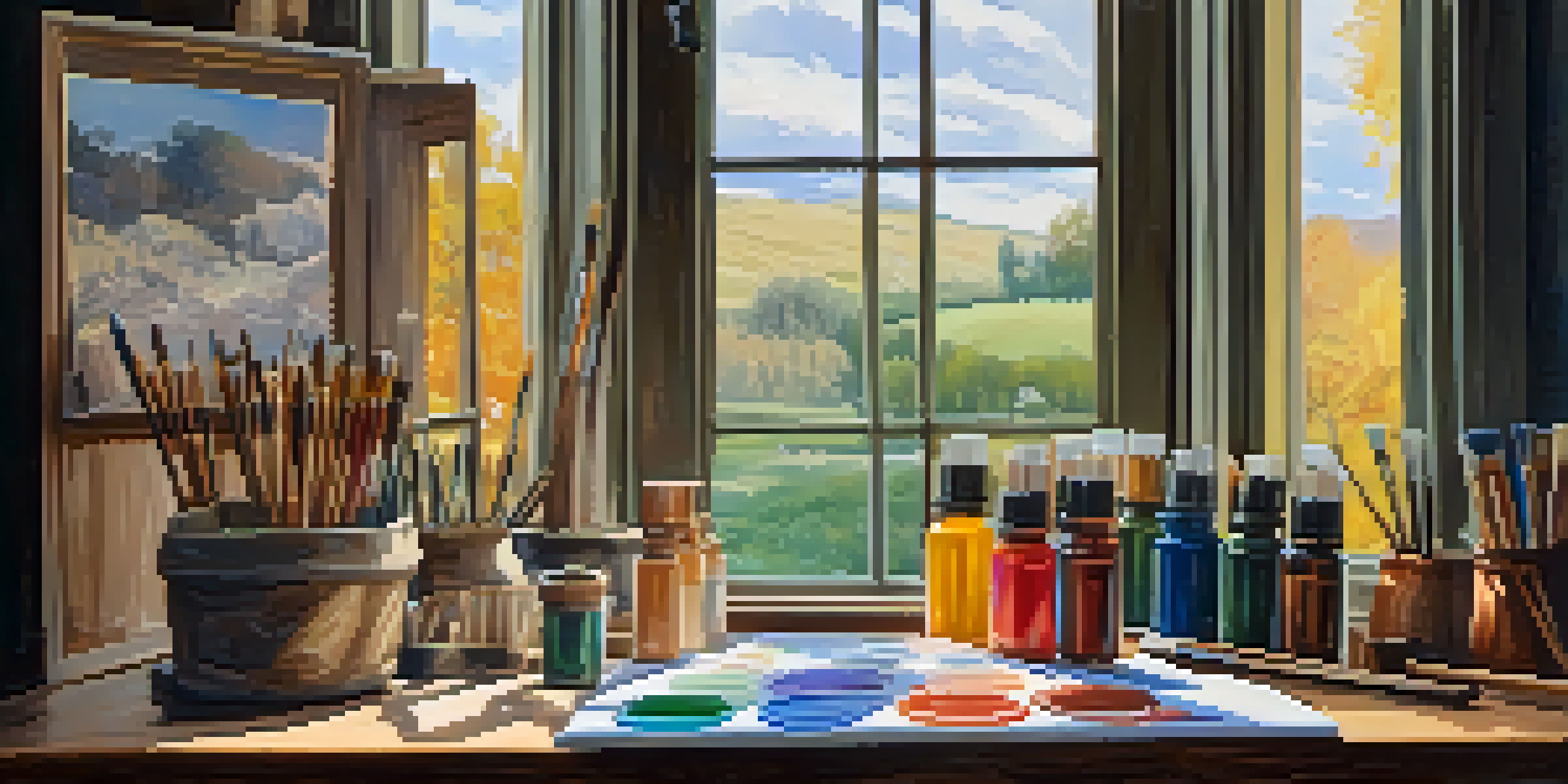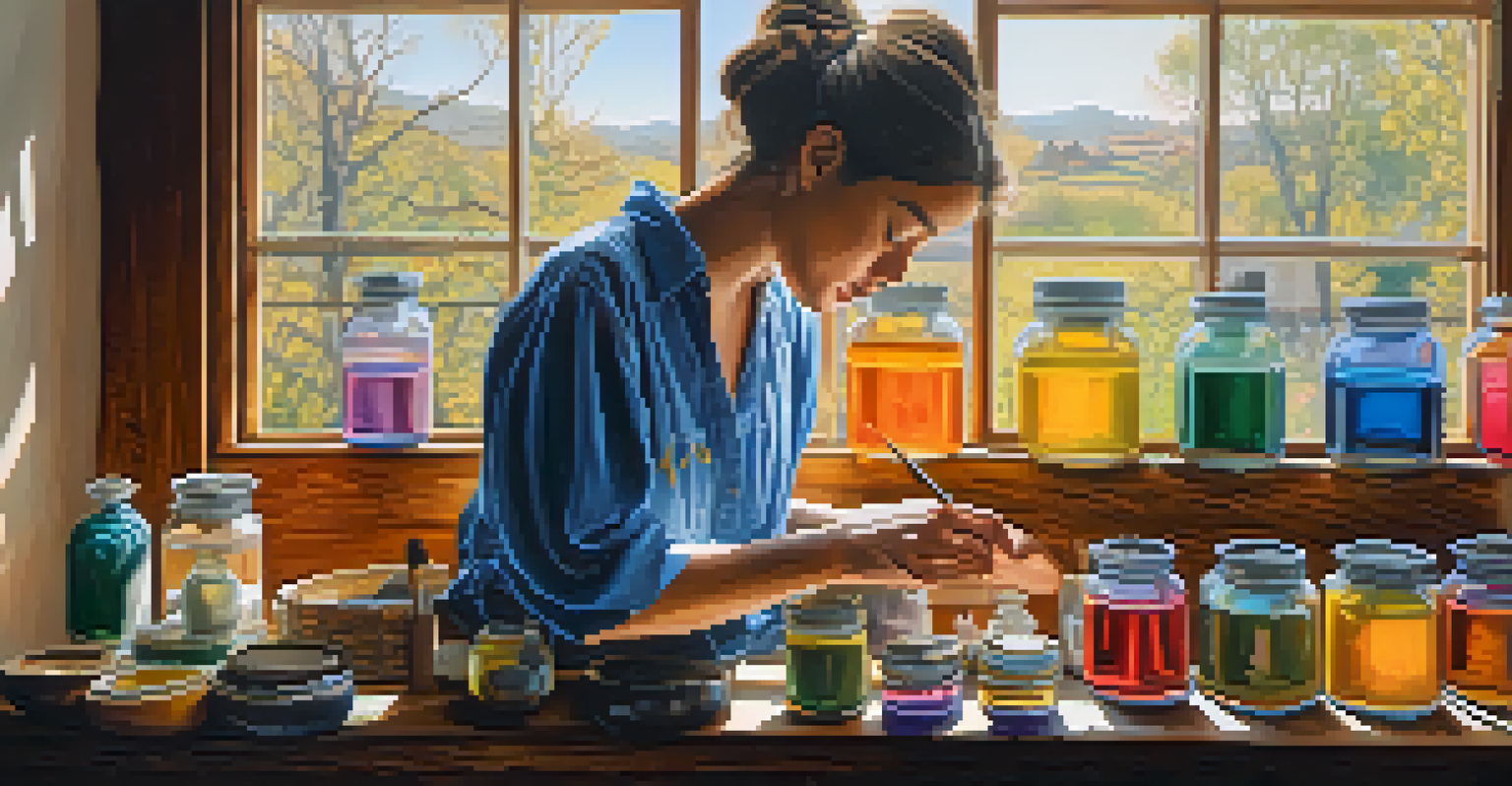Tempera Paint: A Timeless Medium in Art History

What is Tempera Paint and Its Composition
Tempera paint is a fast-drying medium made from colored pigments mixed with a water-soluble binder, often egg yolk. This unique combination gives tempera its characteristic matte finish and vibrant colors. The use of egg as a binder has been a classic method since ancient times, providing a smooth texture that artists love.
Tempera paint is a medium which requires the artist to be both skilled and patient, allowing for intricate detail and depth in every stroke.
Unlike oil paints, which can take days to dry, tempera paint dries quickly, allowing artists to layer colors effectively. This property makes it an ideal choice for detailed works, as artists can build up textures and nuances without waiting long periods. The historical significance of tempera lies in its use by masters like Botticelli and da Vinci, who appreciated its versatility.
In modern times, tempera is often confused with poster paint; however, the two are quite different. While poster paint is more opaque and easier to use for beginners, tempera offers a depth of color and delicacy that experienced artists cherish. Understanding its composition helps appreciate the beauty and complexity of this timeless medium.
A Brief History of Tempera in Art
Tempera paint has a rich history that dates back to ancient Egypt and Greece, where it was used for murals and manuscripts. Early artists valued tempera for its durability and ability to retain color over time, making it a go-to choice for religious and portrait paintings. Its popularity soared during the Renaissance, as artists began to explore its potential for realism and detail.

Famous works like 'The Birth of Venus' by Botticelli showcase the striking colors and precision achievable with tempera. These masterpieces not only highlight the medium's technical possibilities but also its cultural significance during a time of great artistic innovation. This period solidified tempera as a respected medium alongside oils.
Tempera Paint: A Timeless Medium
Tempera paint, made from pigments and a water-soluble binder like egg yolk, offers a matte finish and vibrant colors that artists have cherished since ancient times.
However, as oil paints gained prominence in the 16th century, tempera began to decline in popularity. Some artists continued to use it for specific effects, while others experimented with mixing it with oils. This evolution reflects the ongoing dialogue in the art world about materials, techniques, and artistic expression.
The Techniques of Tempera Painting
Working with tempera requires a different approach than oils. Artists typically use a rigid support, such as wood panels, to prevent the paint from cracking as it dries. Additionally, the paint must be applied in thin layers, which allows for detailed work and vibrant color buildup. This technique often involves using fine brushes for intricate designs.
Art is not what you see, but what you make others see. Tempera invites the artist to share their vision through vibrant colors and intricate details.
One popular method is the use of underpainting, where artists lay down a monochromatic base layer to establish values and shadows before applying color. This technique helps create depth and dimension and can enhance the overall luminosity of the finished piece. The precision required in tempera painting fosters a meditative and focused creative process.
Moreover, mixing different pigments can yield a wide range of hues, making color theory an essential part of the tempera artist's toolkit. Artists often experiment with additives, such as honey or glycerin, to modify the paint's consistency and drying time. This level of control allows for endless creative possibilities, making tempera a rewarding medium to explore.
Famous Tempera Artists Throughout History
Throughout history, several artists have made significant contributions to the world of tempera painting. Among them, Sandro Botticelli stands out for his ethereal works that showcase the medium's ability to convey emotion and beauty. His use of tempera allowed for intricate detailing and soft transitions in color, capturing the essence of the human figure and nature.
Another notable artist, Giorgio Vasari, praised tempera in his writings, emphasizing its importance during the Renaissance. His works, rich in narrative and character, highlight the versatility of tempera beyond simple portraiture. These artists not only shaped the medium's popularity but also influenced the techniques used by future generations.
Rich History of Tempera Art
With roots in ancient Egypt and Greece, tempera gained prominence during the Renaissance, celebrated for its durability and ability to capture detail in masterpieces.
In more recent times, contemporary artists have rediscovered tempera, blending traditional methods with modern aesthetics. This revival speaks to the medium's enduring appeal and adaptability, showcasing how it can still resonate in today's art world. As artists continue to experiment, tempera remains a vital part of the ongoing narrative of art history.
The Revival of Tempera in Modern Art
In recent years, there has been a resurgence of interest in tempera paint among contemporary artists. This revival is partly due to a growing appreciation for traditional techniques and materials that offer a break from the fast-paced digital world. Artists are now experimenting with tempera in innovative ways, often combining it with other media to create unique effects.
Workshops and courses dedicated to tempera painting have sprung up, inviting both beginners and seasoned artists to explore this classic medium. This renewed focus allows artists to connect with art history while developing their unique styles. Additionally, the accessibility of materials makes it easier for anyone interested to dive into tempera painting.
As environmental concerns rise, many artists are drawn to tempera due to its natural ingredients and non-toxic qualities. This aligns with a broader movement towards sustainable art practices, making tempera an appealing choice. The blend of tradition and modernity in tempera painting continues to inspire creativity and innovation in the art community.
Tempera vs. Other Painting Mediums
Comparing tempera to other painting mediums reveals its unique strengths and weaknesses. Unlike oil paints, which offer a rich, glossy finish, tempera dries to a matte surface that can enhance the vibrancy of colors. This difference can significantly influence the overall look and feel of a painting, depending on the artist's intention.
Acrylic paint, another popular medium, shares some similarities with tempera, particularly in its quick-drying properties. However, acrylics can be more versatile in terms of blending and glazing techniques. Artists often choose one over the other based on the desired effect and the specific challenges of their work.
Modern Revival of Tempera Techniques
Contemporary artists are rediscovering tempera, blending traditional methods with modern aesthetics, while embracing its natural ingredients amid a rising focus on sustainable art practices.
Ultimately, the choice of medium comes down to personal preference and artistic goals. Each medium has its unique qualities, and understanding these can help artists make informed decisions that align with their vision. Tempera's rich history and distinctive characteristics make it a valuable option for those seeking to express their creativity.
Getting Started with Tempera Painting
If you're interested in trying your hand at tempera painting, getting started is simple and accessible. Begin by gathering basic materials such as tempera paint, brushes, and a sturdy surface like a wooden panel or heavy paper. Tempera is available in various colors, allowing you to create a vibrant palette right from the start.
One of the joys of tempera is its ease of use; you can mix it with water to adjust the consistency and transparency to suit your style. Start with simple exercises, such as color mixing or creating small studies, to familiarize yourself with the medium's properties. This practice will help you understand how tempera interacts with different surfaces and how colors blend together.

Don't be afraid to experiment! Tempera allows for great creativity, whether you're layering colors, trying different brush techniques, or even incorporating other materials. By embracing the process and allowing yourself to explore, you'll not only develop your skills but also discover the endless possibilities that tempera painting can offer.